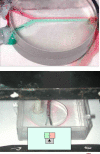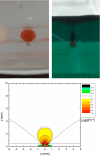Magnetic stabilization and vorticity in submillimeter paramagnetic liquid tubes
- PMID: 19416873
- PMCID: PMC2675569
- DOI: 10.1073/pnas.0900561106
Magnetic stabilization and vorticity in submillimeter paramagnetic liquid tubes
Abstract
It is possible to suppress convection and dispersion of a paramagnetic liquid by means of a magnetic field. A tube of paramagnetic liquid can be stabilized in water along a ferromagnetic track in a vertical magnetic field, but not in a horizontal field. Conversely, an "antitube" of water can be stabilized in a paramagnetic liquid along the same track in a transverse horizontal field, but not in a vertical field. The stability arises from the interaction of the induced moment in the solution with the magnetic field gradient in the vicinity of the track. The magnetic force causes the tube of paramagnetic liquid to behave as if it were encased by an elastic membrane whose cross-section is modified by gravitational forces and Maxwell stress. Convection from the tube to its surroundings is inhibited, but not diffusion. Liquid motion within the paramagnetic tube, however, exhibits vorticity in tubes of diameter 1 mm or less--conditions where classical pipe flow would be perfectly streamline, and mixing extremely slow. The liquid tube is found to slide along the track almost without friction. Paramagnetic liquid tubes and antitubes offer appealing new prospects for mass transport, microfluidics, and electrodeposition.
Conflict of interest statement
The authors declare no conflict of interest.
Figures








References
-
- Cussler EL. Diffusion, Mass Transfer in Fluid Systems. Cambridge, UK: Cambridge Univ Press; 1997. pp. 142–154.
-
- Landau LD, Lifschitz EM. Electrodynamics of Continuous Media. Oxford: Pergamon; 1984. pp. 126–128.
-
- Rosensweig A. Ferrohydrodynamics. New York: Dover; 1997. pp. 13pp. 25–31.pp. 110–118.
-
- Boyer TH. The force on a magnetic dipole. Am J Phys. 1988;56:688–691.
-
- Coey JMD. Magnetism and Magnetic Materials. Cambridge, UK: Cambridge Univ Press; 2009. in press.
Publication types
LinkOut - more resources
Full Text Sources
Other Literature Sources

